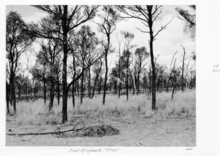| Black gidyea | |
|---|---|

| |
| Scientific classification | |
| Kingdom: | Plantae |
| Clade: | Tracheophytes |
| Clade: | Angiosperms |
| Clade: | Eudicots |
| Clade: | Rosids |
| Order: | Fabales |
| Family: | Fabaceae |
| Subfamily: | Caesalpinioideae |
| Clade: | Mimosoid clade |
| Genus: | Acacia |
| Species: | A. argyrodendron
|
| Binomial name | |
| Acacia argyrodendron | |

| |
| Occurrence data from AVH | |
Acacia argyrodendron, known colloquially as black gidyea or blackwood, is a species of Acacia native to Australia. Czech botanist Karel Domin described this species in 1926 and it still bears its original name. Domin reported collecting the type specimen from somewhere between Camooweal and Burketown in northwestern Queensland, though it is more likely to have been northeast of Aramac.[1]
Description[edit]
Acacia argyrodendron is a tree, reaching 8 to 25 m (26 to 82 ft) high, and has dark grey to black bark.[2] Like most species of Acacia it has phyllodes rather than true leaves. The ascending and evergreen phyllodes have a narrowly linear-elliptic shape and are straight or sometimes a little recurved. The leathery glabrous to subglabrous phyllodes are 8 to 17 cm (3.1 to 6.7 in) in length and 4 to 9 mm (0.16 to 0.35 in) wide and have many closely parallel nerves where one to three of the nerves are far more prominent than the others. When it blooms it produces inflorescences that occur in groups of 12 to 30 along an axis that is 2 to 6 cm (0.79 to 2.36 in) in length. the spherical flower-heads have a diameter of approximately 3.5 mm (0.14 in) and contain 12 to 20 golden coloured flowers. Following flowering thin and glabrous seed pods form that are up to 12 cm (4.7 in) in length and 10 to 13 mm (0.39 to 0.51 in) wide. The dull brown seeds inside the pods are soft with an elliptic to broadly oblong shape and are 10 to 13 mm (0.39 to 0.51 in) in length.[3]
Taxonomy[edit]
The species was first formally described by the botanist Karel Domin in 1926 as part of the work Beitrage zur Flora und Pflanzengeographie Australiens as published in the work Bibliotheca Botanica. It was reclassified as Racosperma argyrodendron in 1987 by Leslie Pedley then transferred back to genus Acacia in 2001.[4]
Distribution[edit]
Acacia argyrodendron is found in central Queensland in the basins of the Cape, Suttor and Belyando Rivers on clay soils in areas where the annual rainfall ranges between 475 and 655 mm (18.7 and 25.8 in). It forms open forests as the dominant (and sometimes only) tree species. Associated understory plants include shrub species such as the false sandalwood (Eremophila mitchellii), yellow-wood (Terminalia oblongata) and conkerberry (Carissa spinarum), and smaller herbaceous plants such as brigalow grass (Paspalidium caespitosum), yakka grass (Sporobolus caroli), blue trumpet (Brunoniella australis) and Dipteracanthus australasicus. Occasionally, there may be trees such as Dawson River blackbutt (Eucalyptus cambageana), coolibah (E. coolabah) and Brown's box (E. brownii).[5]
Gidgee (A. cambagei) replaces it in drier habitats, while brigalow (Acacia harpophylla) replaces it in wetter areas,[5] as well as overlapping for part of the southern and eastern parts of its range.[2]
It has been recorded as a host plant for the mistletoe species Amyema preissii, Amyema quandang and Lysiana exocarpi.[6]
See also[edit]
References[edit]
- ^ "Acacia argyrodendron Domin". Australian Plant Name Index (APNI), IBIS database. Centre for Plant Biodiversity Research, Australian Government.
- ^ a b Orchard, A. E.; Wilson, Annette (2001). Flora of Australia:Mimosaceae. Vol. 11. Collingwood, Victoria: CSIRO Publishing. p. 120. ISBN 978-0-643-06720-2.
- ^ "Acacia argyrodendron". World Wide Wattle. Western Australian Herbarium. Retrieved 5 October 2020.
- ^ "Acacia argyrodendron Domin". Atlas of Living Australia. Global Biodiversity Information Facility. Retrieved 5 October 2020.
- ^ a b Groves, R.H. (1994). Australian vegetation. Cambridge University Press. p. 269. ISBN 978-0-521-42476-9.
- ^ Downey, Paul O. (1998). "An inventory of host species for each aerial mistletoe species (Loranthaceae and Viscaceae) in Australia" (PDF). Cunninghamia. 5 (3): 685–720. Archived from the original (PDF) on 2012-04-26.